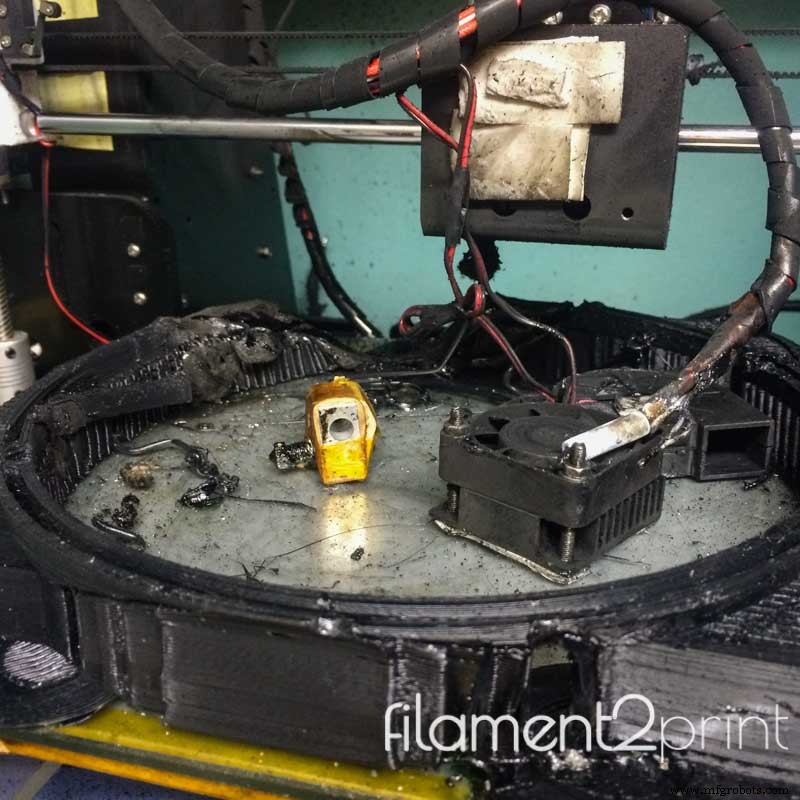Risiken beim Drucken in 3D

Jeden Tag 3D-Druck ist sowohl auf industrieller als auch auf häuslicher Ebene weiter verbreitet, was die Entwicklung vieler Anwendungen fördert in einer Vielzahl von Bereichen. Auf Medienebene stechen nur die Vorteile der Technologie hervor, aber es gibt bestimmte Vorsichtsmaßnahmen, die getroffen werden müssen beim Einstieg in die Welt des 3D-Drucks berücksichtigen.
Aber jeder Anwender muss mit gewissen Risiken rechnen, die beim 3D-Druck auftreten können. Die beiden Hauptrisikoquellen und häufiger sind zum einen die beim Schmelzen des Materials freigesetzten Gase und zum anderen die möglichen Brandherde durch Missbrauch des 3D-Druckers oder den schlechten Zustand der Elektronik desselben.
Im Folgenden beschreiben wir die Hauptrisikoquellen sowie die Vorsichtsmaßnahmen, die zur Vermeidung größerer Probleme zu treffen sind:
Freigesetzte Gase und Gerüche
Alle Materialien, die beim 3D-FDM/FFF-Druck verwendet werden, sind Kunststoff oder enthalten einen Teil dieses Materials. An dieser Stelle konzentrieren wir uns auf die drei häufigsten:PLA, ABS und HIPS.
ABS und HIPS sind zwei sehr weit verbreitete Materialien im 3D-Druck Außerdem ist es sehr üblich, sie in Kombination zu verwenden, HIPS als Trägermaterial (es ist in D-Limonen gelöst) und ABS als Basismaterial. Diese beiden Materialien haben den Nachteil, dass bei ihrer Verschmelzung eine Styrolmenge freigesetzt wird, die 20-mal höher ist als die in der Atmosphäre vorhandene , krebserregend bei längerer Einatmung dieser emittierten Gase.
Das PLA ist ein einfach zu druckendes Material auf jedem 3D-Drucker und damit das vielseitigste aller existierenden Materialien für den 3D-Druck. In Bezug auf den erzeugten Abfall wird Lactid freigesetzt , ein Element, das weder das oben erwähnte ABS-Problem darstellt noch die Gesundheit der Menschen beeinträchtigt .
Darüber hinaus integrieren industrielle 3D-Drucker den HEPA-Filter , which is a type of high efficiency air filter that meets high standards. Therefore, if you don't have a closed 3D printer with a HEPA filter, the main recommendation is to keep the place of printing well ventilated (care must be taken with drafts since they cause the dreaded warping and cracking effect in open 3D printers).
Therefore, in domestic environments, it's advisable to print filaments that don't emit odors as long as they comply with the mechanical properties.
Possible fire sources

Image 1:Possible fire sources
At this point we must take into account first of all that 3D printers that don't have the CE mark (European Certificate) don't pass any quality control , something that can become very dangerous in the event of a failure.
Electricity
It must be taken into account that the characteristics of the electrical network to which the 3D printer is connected must be exactly those indicated on the machine:230 Vac, 50Hz. In addition, attention should be paid to where the 3D printer connects. If it's fed from a terminal strip with more consumers, it can cause fuses to blow or the protections of the installation to skip. Therefore, the characteristics of the line must be checked before connection . When cleaning the 3D printer, always disconnect the 3D printer from the electrical outlets to avoid accidental contacts.
Electronics
The use of quality electronic components , as well as cables with the appropriate section is crucial to avoid excess temperatures that can lead to the fire of the 3D printer itself and this, in turn, of everything that is around it. Another possible problem that can also cause a fire is that the temperature sensor comes out of its housing and the heating cartridge raises its temperature to the maximum, melting the elements that are around it and can cause fire.
Hot parts
Sometimes by inertia or forgetfulness you tend to put your hand inside the 3D printer while it's still hot, which can cause severe burns to the skin . We mustn't forget that the operation of a 3D printer is based on the principle of polymer melting, which implies a high temperature in the heating elements.
In addition, the fact that the 3D printer is switched off or unplugged after finishing an impression doesn't imply that the heating elements are cold, so it shouldn't be touched until enough time has passed.
Mobile parts
For the movement of the 3 axes, as well as that of the 2 extruders, electrical motors are used step by step with high torque. When you put your fingers or your hand in the areas of the shafts, spindles and belts, it can cause entrapments, bruises and wounds , as well as burns due to the heat dissipated by the motors. Therefore, we must be very careful when entering the hand inside the 3D printer , and should only be done if strictly necessary, and to be able to be with security measures to prevent further damage in the event of an accident.
Fixing spray
When applying the base fixative spray (3DLac, DimaFix or PrintaFix) it must be done outside the 3D printer since they are highly inflammable products that in contact with high temperatures or residual electric currents can cause a flame. Although it seems incredible, there have already been more than one case where a house is burned or something worse because of the wrong process.
Our particular recommendation is that at all times you have proof (especially when you have a 3D printer in a domestic environment), that this isn't a "toy", and that its operation carries associated risks. It's always better to have 3D printers with CE marking that have a closed housing and HEPA filter, and if possible in ventilated places.
3d Drucken
- 5 Sicherheitstipps, die Sie bei der Verwendung eines 3D-Druckers beachten sollten
- Die kommenden 3D-Druckermodelle, die Sie kennen müssen
- Imperial College London stellt neue Metalldrucktechnologie vor
- Was kann man mit einem 3D-Drucker herstellen?
- Können Sie Ihren 3D-Drucker unbeaufsichtigt lassen? Drucken über Nacht
- Ist 3D-Druck einfach?
- Was ist ein PolyJet-Drucker? Ist es FDM oder SLA ähnlich?
- Online-Kurse zu 3D-Druck und 3D-Design; Kostenlos und kostenpflichtig!
- So reinigen Sie ein 3D-Druckerbett:So richtig!
- Die 6 wichtigsten Punkte, die beim Kauf eines 3D-Druckers zu berücksichtigen sind



